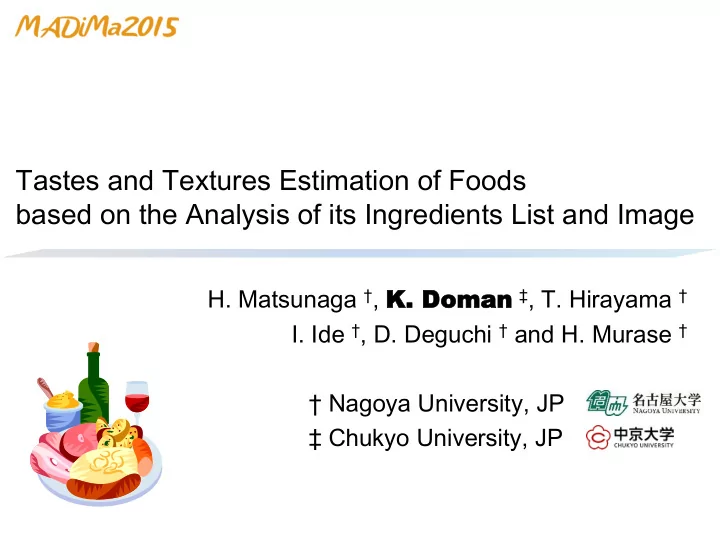

Tastes and Textures Estimation of Foods based on the Analysis of its Ingredients List and Image H. Matsunaga † , K. D . Doman oman ‡ , T. Hirayama † I. Ide † , D. Deguchi † and H. Murase † † Nagoya University, JP ‡ Chukyo University, JP
Background Numerous cooking recipes are available on the Web Users need to choose one from them More than 2M cooking recipes Choose one Search Close to 1M Cooking recipe cooking recipes 2
Way of recipe search Keyword matching with recipe titles, names of ingredients, etc. Problem: Difficult to search by tastes Solution: Taste estimation from a cooking recipe Sweet Chilly Sour 3
Concept Focus on the correlations between A) Ingredients and taste Ex) Pineapple should be sweet and/or sour Ex) Red pepper should be chilly B) Appearance and taste Ex) Red foods are likely to be chilly 4
Approach Tastes estimation based on Image features from a food image Ingredients feature from the list of ingredients Red pepper • Tofu • Minced meat • Chilly Potato starch • … • Food image List of ingredients 5
Proposed method Training step for each taste class Sweet, salty, sour, chilly and bitter Cooking recipes with taste labels Extract ingredients features and image features Construct a taste classifier Classifier 6
Proposed method Estimation step Cooking recipe Extract ingredients feature and image features Estimate taste classes Sweet Salty Sour Chilly Bitter ? ? ? ? ? 7
Proposed method Estimation step Cooking recipe Extract ingredients feature and image features Estimate taste classes Sweet Salty Sour Chilly Bitter ? ? ? ? ? 8
Ingredients feature Binary vector representing the ingredients used in a cooking recipe Hamburger Minced meat 1 Onion 1 Ingredients: Egg 1 • Minced meat Pumpkin 0 • Onion Milk 1 • Egg Breadcrumbs 1 • Milk Ketchup 0 • Breadcrumbs Cooking recipe Components Ingredient vector (List of ingredients) 9
Image features Composition of several image features Color-based Hue-saturation histogram Hue-saturation correlogram Joined into a single vector Gradient-based SIFT+BoF HOG 10
Proposed method Estimation step Cooking recipe Extract ingredients feature and image features Estimate taste classes Sweet Salty Sour Chilly Bitter ? ? ? ? ? 11
Taste classifiers Linear SVM for each taste class One-versus-rest classifier Judge whether an input food has the corresponding taste or not Allow an input food to have multiple tastes Taste Result • Kimchi Sweet No • Onion • Tofu Salty No • ... Sour Yes Chilly Yes Food image Ingredients Bitter No 12
Experimental dataset 1,827 cooking recipes Provided by Rakuten, Inc. Labeled manually by human subjects Taste class #Positives #Negatives #Total Sweet 1,254 573 1,827 Salty 537 1,290 1,827 Sour 366 1,461 1,827 Chilly 241 1,586 1,827 Bitter 213 1,614 1,827 13
Experimental results Method: 8-fold cross validation Estimation accuracy: F-measure Ingredients Ingredients Image Taste class + Image feature features (Proposed) Sweet 0.822 0.798 0.825 Salty 0.547 0.359 0.542 Sour 0.362 0.319 0.397 Chilly 0.256 0.142 0.282 Bitter 0.376 0.216 0.404 14
Discussion for the salty class Why the ingredients feature was the best Many foods with salt are salty Salt is usually not visually perceivable Ingredients Ingredients Image Taste class + Image feature features (Proposed) Salty 0.547 0.359 0.542 Selecting different features for each class can improve the accuracy 15
Application to textures estimation Ingredients feature was effective for some texture classes Ingredients Ingredients Image Texture class + Image feature features (Proposed) Shaki-shaki 0.732 0.514 0.726 Fuwa-fuwa 0.643 0.432 0.645 Toro-toro 0.378 0.310 0.363 Saku-saku 0.526 0.346 0.539 Hoku-hoku 0.660 0.333 0.650 16
Conclusion Proposed method Tastes estimation from a cooking recipe Use ingredients feature and image features Experimental results Showed the effectiveness for tastes estimation Showed the extensibility to textures estimation 17
Recommend
More recommend